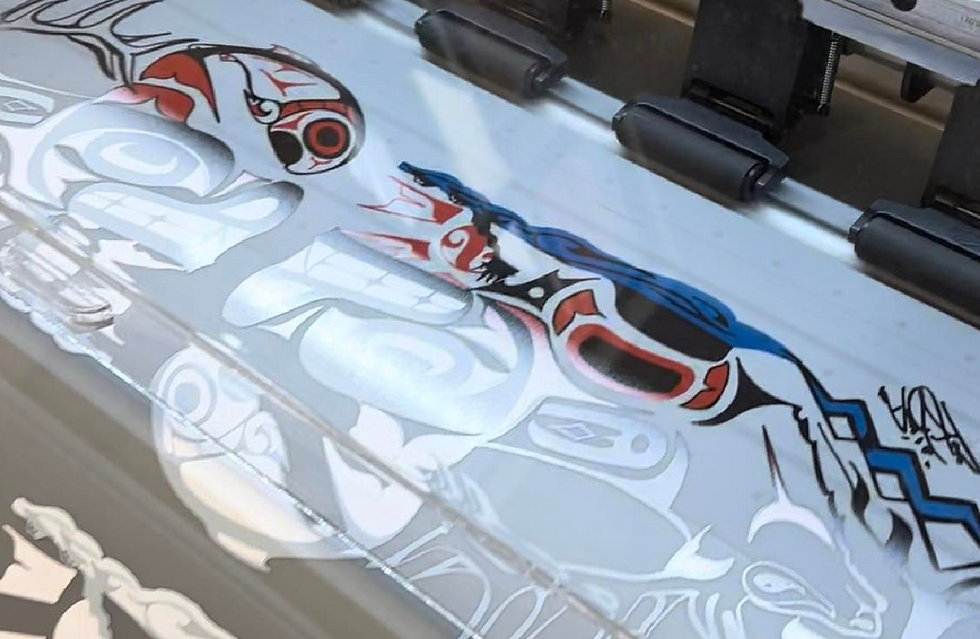OPTIMAL GRAPHIC FILE FORMAT, COLORS, AND RESOLUTION FOR DTF & UV DTF PRINTING
- Elena Duggan
- Sep 6, 2022
- 3 min read
Updated: Apr 24
Using high-quality artwork is essential for printing top-quality DTF transfers. The quality of your design directly impacts the final result—even the best ink and equipment can’t compensate for poor artwork. To get the best outcome, always start with high-resolution, print-ready files.
✅ Use a Transparent Background
Nobody wants a white rectangle around their design. Be sure your artwork has a transparent background—especially for logos, text, or cut-out elements.
🧠 Understand the Power of Pixels
When working with PNG format, keep in mind it’s raster-based, meaning it's made of pixels. The resolution depends on DPI (dots per inch)—the higher the DPI, the sharper and more detailed the image.
Important:You can always scale down high-resolution artwork, but you cannot scale it up without losing quality. For example, you can reduce a 300 DPI image to 72 DPI, but increasing a 72 DPI image to 300 DPI won’t improve its clarity—it’ll just look blurry.

⚠️ The One Exception
If you have an image with very large pixel dimensions—for example, 3200 x 2400 pixels (about 45" x 34") at 72 DPI—it may still maintain decent quality when resized. But starting with 300 DPI is always best.
🎨 Managing Color Expectations
Colors often vary between screens and prints. We calibrate our printers and use a custom ICC profile designed for our ink and DTF film to ensure consistency.
That said, if precise color matching is important to you, we strongly recommend ordering one of our Color Charts—available in regular or oversized formats for easier reading.
💡 Bright colors like lime green, highlighter yellow, bright magenta, and vibrant blues may not print as vividly. These are often affected during the RGB to CMYK conversion. With the help of our Color Chart and some design adjustments, you can get much closer to your desired result.
Understanding DPI and Image Enlargement
DPI refers to the number of dots (or pixels) per inch. When you enlarge an image without adding more pixels, you reduce the number of pixels per inch—resulting in a lower DPI and reduced clarity.
Example: A 2" x 2" image at 300 DPI = 600 x 600 pixels.If you enlarge it to 4" x 4", but don’t add more pixels, that same 600 pixels now spread across a larger area—making it 150 DPI (600 ÷ 4").Result: a blurrier, less sharp print.
Why Colors Look Different on Screen vs. Printed
Screens use RGB color, which blends red, green, and blue light to create bright, vibrant colors.Printers use CMYK, which combines physical ink—cyan, magenta, yellow, and black—on paper or film. This subtractive method can make colors appear duller or less vibrant.
Think of it this way:A monitor displays glowing light. A printer lays down ink. Even if a screen shows bright neon pink, the printer will do its best to match it, but the result may not be as vibrant.
If color accuracy is critical, please order a Color Chart before printing and adjust your graphics based on what’s printable.
On Screen vs. Printed
What you see on the screen and how it will print

Not Sure If Your Art is Print-Ready?
If you're unsure whether your file is suitable for DTF printing, feel free to email us at order@pnwprintco.com.If your file is low-resolution but you’re aiming for a high-quality finish, we offer vectorization services for a small fee. We'll clean up your artwork and get it ready for beautiful results.
Important Note:
We cannot be held responsible for poor print outcomes caused by low-resolution artwork.We also do not review gang sheets for overlapping designs or assess image quality before printing. Often, we only see issues once the sheet is printed—and by that point, it cannot be canceled or changed.
Please double-check your files before uploading to avoid disappointment.





Is there a sample sheet I can order to see if my design will work for my hats and koozies? I just had my design digitized for my embroidery machine and sent the file in for png or pdf and was 300 dpi. thank you for your time answering any and all questions.